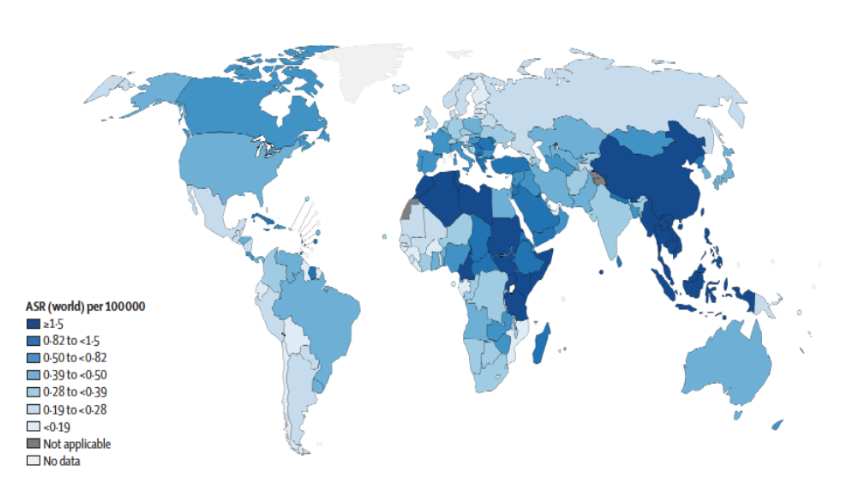NPC R/M

Adapted from: National Cancer Institute - Nasopharyngeal Carcinoma Treatment (PDQ®) – Health Professional Version – Available here – Accessed 11/26/2024.
Introduction 1
Among the types of head and neck cancer, NPC (Nasopharyngeal Cancer) is the most peculiar type of malignancy, as its clinical behavior, epidemiology and histopathology are different from other head and neck squamous cell carcinomas. In addition, its consistent association with EBV (Epstein-Barr Virus) and its marked geographical differences are specific features.
WHO classification 2005 1.2
WHO TYPE I - Keratinizing SCC – 20-25%
Risk factors: Excessive alcohol intake and history of smoking.
WHO TYPE II - Non-keratinizing SCC:
-
Differentiated non-keratinizing SCC – 10-15%
-
Undifferentiated nonkeratinizing SCC – 60-65%
Risk factors: Asian descent, EBV exposure and family history.
WHO TYPE III - Basaloid SCC
Epidemiology 1

-
Incidence (2022): 120 thousand new cases (0.6%).
-
Mortality (2022): 73 thousand deaths (0.8%).
-
China: Ratio of 2.5 men to 1 woman.
Incidence Peaks by Age Group and Sex 4.5
-
Non-endemic areas: 15-24 years and after 65 years.
-
Endemic areas: 40-59 years.
Incidence ratio (IR) for men and women: 2.75
Geographical Distribution:
NPC is rare in many regions of the world, but is endemic in North Africa and Southeast Asia, with a notable incidence in Southern China.
In low incidence areas, NPC increases with age and has two specific peaks: adolescents and adults over 65 years of age. In endemic areas, the incidence increases among adults after 30 years of age, with peaks in adults aged 40 to 59 years. 3-5
In Brazil:
-
Estimated incidence : 0.5 to 1 case per 100,000 men and 0.3 cases per 100,000 women.
Signs and Symptoms 1
The main signs and symptoms include:
-
Headache caused by dysfunction of cranial nerves (II-VI or IX-XII).
-
Diplopia .
-
Facial numbness .
-
Cervical adenopathy – present in approximately 75% of patients and often bilateral and posterior.
-
Nasal obstruction .
-
Epistaxis .
-
Decreased hearing .
-
Buzzing .
-
Otitis media .
-
Sore throat .
Note: In patients with cervical adenopathy alone, the finding of EBV genomic material by PCR (polymerase chain reaction) is strong evidence of a primary nasopharyngeal tumor. This region should be examined closely.
Diagnosis 1
Diagnosis is made by biopsy of the nasopharyngeal mass. The following procedures aid in diagnosis:
-
Fiber optic nasal endoscopy .
-
Endoscopic biopsy .
-
Anamnesis and analysis of family history.
-
Assessment of cranial nerve function , including neuro-ophthalmological and audiological evaluation.
-
Computed tomography (CT) .
-
Magnetic resonance imaging (MRI) .
-
Testing for circulating cancer-derived EBV DNA in plasma .
-
Blood test for HPV type 16 (if EBV is negative).
Acronyms and Abbreviations
-
NPC: Nasopharyngeal Cancer
-
ASR: Age Standardised Incidence-Rate
-
IR: Incidence Ratio
-
EBV: Epstein-Barr Virus
References
-
National Cancer Institute - Nasopharyngeal Carcinoma Treatment (PDQ®) – Health Professional Version. Available at: https://www.cancer.gov/types/head-and-neck/hp/adult/nasopharyngeal-treatment-pdq#_163 . Accessed on 11/26/2024.
-
PathologyOutlines.com - Available at: www.pathologyoutlines.com . Accessed on 11/21/2024.
-
Cantú, Giulio. Nasopharyngeal carcinoma. A "different" head and neck tumor. Part A: from histology to staging. Acta Otorhinolaryngol Ital. 2023 Apr;43(2):85-98. Available at: https://pubmed.ncbi.nlm.nih.gov/37099432/ . Accessed on 11/26/2024.
-
Chen, Y.P., et al. Lancet. 2019; 394:64-80.
-
Bray, F, et al. GLOBOCAN 2022 . CA Cancer J Clin. 2022;74(3):229-263.